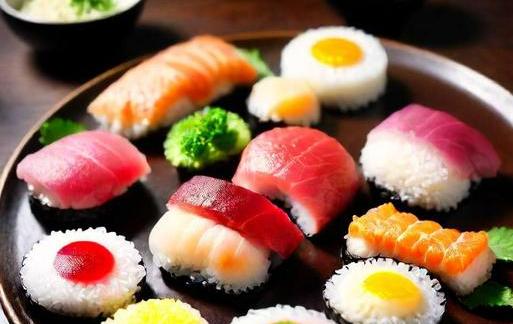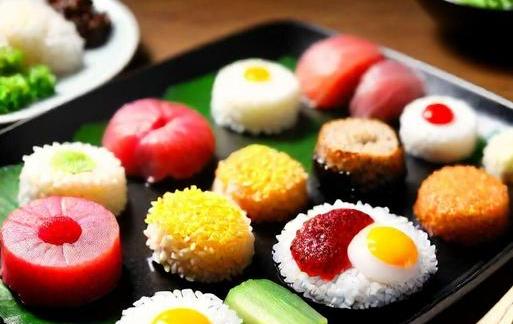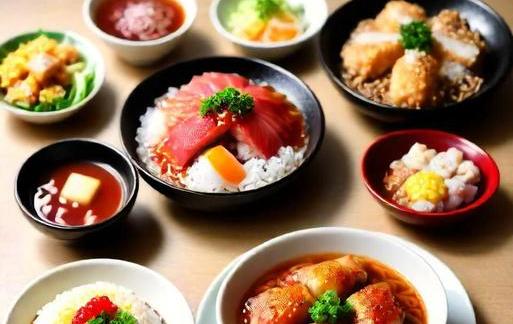- You are here:
- Home »
- Food
- » [REVEALED] Japanese Foods That Start With T
[REVEALED] Japanese Foods That Start With T
Note: This page contains affiliate links.
As an Amazon Associate, I earn from qualifying purchases when you click on the link, but you are not charged extra.
Japanese cuisine is a fascinating tapestry of flavors, textures, and traditions. From delicate sushi to hearty ramen, Japanese food has gained global acclaim for its artful presentation and meticulous preparation. In this gastronomic journey, we delve into the diverse world of Japanese foods that start with the letter "T." From iconic dishes to lesser-known culinary delights, this article explores the rich tapestry of Japanese cuisine.
Contents
List Of Japanese Foods That Start With T

1. Takoyaki (たこ焼き)
Takoyaki, often referred to as "octopus balls," is a beloved street food originating from Osaka. These delectable spheres are made from batter filled with diced octopus, tempura scraps, pickled ginger, and green onions. Cooked in a special molded pan, Takoyaki is then topped with savory sauces, bonito flakes, and seaweed powder. The result is a crispy exterior and a gooey, flavorful interior, creating a delightful harmony of tastes and textures.
2. Tempura (天ぷら)
Tempura is a culinary art form that involves deep-frying seafood or vegetables in a light, airy batter. Introduced by Portuguese missionaries in the 16th century, Tempura has evolved into a quintessential Japanese dish. Common ingredients include shrimp, sweet potatoes, and eggplant. The batter, made with flour, ice-cold water, and sometimes egg, results in a crispy, golden exterior that encases the succulent, perfectly cooked interior. Tempura is typically served with a dipping sauce called "tentsuyu."
3. Tofu (豆腐)
Tofu, a staple in Japanese cuisine, is made from soybeans and has a delicate, neutral flavor. It is a versatile ingredient that can be used in various dishes, from soups to desserts. Silken tofu is often used in miso soup, while firm or extra-firm varieties can be grilled, stir-fried, or used in hot pots. Tofu is valued not only for its taste but also for its health benefits, being a good source of protein and low in calories.
4. Tonkatsu (とんかつ)
Tonkatsu is a popular Japanese dish consisting of breaded and deep-fried pork cutlet. The pork is usually tenderized before being coated in flour, beaten eggs, and panko breadcrumbs. It is then deep-fried until golden brown and served with a tangy tonkatsu sauce. This dish showcases the Japanese mastery of frying techniques, resulting in a crispy exterior that contrasts with the juicy pork inside.
5. Tsukemono (漬物)
Tsukemono refers to Japanese pickles that come in a variety of flavors and styles. Commonly made with cucumbers, radishes, or eggplants, these pickles are seasoned with ingredients like salt, rice bran, or vinegar. Tsukemono serves as a palate cleanser and a refreshing accompaniment to rice dishes. The art of pickling has deep roots in Japanese culinary history, and regional variations add a unique touch to these flavorful additions.
6. Takuan (沢庵)
Takuan is a type of tsukemono made from daikon radish, known for its distinctive yellow color. The radish is first sun-dried and then pickled in a mixture of rice bran, salt, and sugar. Takuan has a crunchy texture and a slightly sweet, tangy taste. It is often served alongside rice, in bento boxes, or as a garnish for other dishes. The pickling process not only preserves the daikon but also imparts a unique flavor profile.
7. Tamago Sushi (卵寿司)
Tamago Sushi, or sweet omelet sushi, is a type of sushi that features a rolled or layered omelet on a bed of seasoned rice and wrapped in a strip of seaweed. The omelet is made with a mixture of eggs, sugar, and sometimes soy sauce, creating a sweet and savory combination. Tamago Sushi is a favorite among those who appreciate the balance of flavors and the smooth, custard-like texture of the omelet.
8. Taiyaki (たい焼き)
Taiyaki, shaped like a fish, is a popular Japanese street food and dessert. The name "tai" means sea bream in Japanese, and the pastry is often filled with sweet red bean paste, custard, chocolate, or sweet potato. The batter is poured into fish-shaped molds and cooked until golden brown. Taiyaki is not only a delicious treat but also an iconic symbol of Japanese street food culture.
9. Takikomi Gohan (炊き込みご飯)
Takikomi Gohan, often translated as "mixed rice," is a one-pot dish where rice is cooked with various ingredients and seasoned with soy sauce, sake, and dashi. The additional ingredients can include vegetables, mushrooms, chicken, or seafood. This dish captures the essence of umami, with the rice absorbing the flavors of the accompanying elements. Takikomi Gohan is not only flavorful but also a wholesome meal that reflects the seasonal bounty.
10. Tendon (天丼)
Tendon, short for tempura donburi, is a rice bowl dish topped with assorted tempura and drizzled with a savory soy-based sauce. The tempura can include shrimp, vegetables, and other seafood, creating a delightful combination of textures and flavors. Tendon is often served with a side of miso soup and pickles. This dish exemplifies the Japanese culinary philosophy of using fresh, high-quality ingredients to create a harmonious dining experience.
11. Tororo (とろろ)
Tororo is a traditional Japanese dish made from grated mountain yam, known as "nagaimo" in Japanese. The yam is grated into a slimy, viscous texture and often served over rice. Tororo is prized for its unique texture and subtle, earthy flavor. It can be enjoyed on its own or as a topping for other dishes. The dish is not only delicious but also known for its potential health benefits, as nagaimo is believed to have digestive and anti-inflammatory properties.
12. Tsukudani (佃煮)
Tsukudani is a type of preserved food in which ingredients such as seaweed, fish, or shellfish are simmered in soy sauce, mirin, and sake until they become intensely flavored. The resulting product is a savory, slightly sweet condiment that can be served over rice or used as a topping for various dishes. Tsukudani showcases the Japanese art of preserving and intensifying flavors, providing a burst of umami in every bite.
Japanese cuisine, with its meticulous preparation and emphasis on fresh, seasonal ingredients, continues to captivate food enthusiasts worldwide. The foods that start with "T" in Japanese culinary repertoire offer a diverse range of flavors, textures, and cultural significance. From the street food charm of takoyaki to the refined elegance of tamago sushi, each dish reflects the rich tapestry of Japan's culinary heritage. As we explore the world of Japanese foods that start with "T", it becomes evident that these dishes not only satisfy the palate but also tell a story of tradition, innovation, and a deep connection to nature. Whether you are savoring the crispy goodness of tempura or indulging in the sweet delight of taiyaki, each bite is an invitation to experience the artistry and craftsmanship embedded in Japanese culinary traditions. The "T" in Japanese cuisine goes beyond just a letter—it represents a journey through taste, culture, and a profound appreciation for the culinary arts. So, the next time you explore Japanese cuisine, don't miss the opportunity to savor the tantalizing array of dishes that start with the letter "T".
Significance

Japanese cuisine is renowned for its exquisite flavors, meticulous preparation, and cultural significance. Among the diverse array of dishes that make up this culinary landscape, there exists a fascinating selection of foods that start with the letter "T." In this comprehensive exploration, we delve into the world of Japanese cuisine, uncovering the significance of these foods, their categorization, common themes, and intriguing facts that contribute to the rich tapestry of Japanese culinary heritage.
Understanding the significance of Japanese foods that start with "T" requires a glimpse into the cultural and historical context of Japan. The meticulous preparation, respect for ingredients, and emphasis on presentation in Japanese cuisine are deeply ingrained in the nation’s traditions. Food plays a pivotal role in Japanese culture, symbolizing not just sustenance but also an art form that reflects the seasons, craftsmanship, and regional diversity. Exploring foods starting with the letter "T" provides a unique lens through which to appreciate the depth and variety of Japanese culinary artistry.
Category-Related

To comprehend the scope of Japanese foods that start with "T," it’s essential to categorize them based on their nature. The letter "T" encompasses a diverse range of dishes, spanning from traditional to contemporary. Let’s explore this category-related breakdown:
1. Traditional Delicacies
a. Tempura (天ぷら): A hallmark of Japanese cuisine, tempura consists of deep-fried seafood or vegetables coated in a light, airy batter. The dish showcases the delicate art of frying, resulting in a crisp exterior that contrasts with the tender interior.
b. Takoyaki (たこ焼き): Hailing from Osaka, takoyaki are savory octopus-filled dough balls, cooked to perfection in a special molded pan. Often garnished with bonito flakes, takoyaki exemplifies the playful and flavorful side of Japanese street food.
2. Soul-Satisfying Soups
a. Tonkotsu Ramen (豚骨ラーメン): This hearty noodle soup features a rich and creamy broth made from pork bones. Combined with chewy ramen noodles, slices of pork belly, and an assortment of toppings, tonkotsu ramen is a comforting bowl that warms both body and soul.
b. Tsujiura Soba (辻占蕎麦): Originating from the Tsujiura area in Toyama Prefecture, this regional soba dish is celebrated for its unique buckwheat noodles and flavorful broth. Served hot or cold, Tsujiura soba reflects the nuanced regional variations within Japanese cuisine.
3. Sweets And Treats
a. Taiyaki (たい焼き): Shaped like a fish, taiyaki is a delectable fish-shaped pastry filled with sweet fillings such as red bean paste, custard, or chocolate. This popular street food captures the essence of Japanese dessert culture.
b. Tokyo Banana (東京ばな奈): A beloved souvenir from Tokyo, these banana-shaped sponge cakes are filled with banana-flavored custard. Tokyo Banana has become an iconic sweet treat, representing the fusion of traditional and modern flavors.
Common Themes
Within the realm of Japanese foods starting with "T," several common themes emerge, highlighting the interconnectedness of ingredients, seasonality, and culinary techniques. These themes contribute to the harmonious balance and aesthetic appeal that define Japanese cuisine.
1. Umami Elevation
Japanese foods, regardless of the letter they begin with, often share a dedication to enhancing umami, the fifth taste. "T" dishes are no exception. Ingredients such as dashi (a broth made from fish and seaweed) and miso (fermented soybean paste) play crucial roles in elevating umami, imparting depth and complexity to a range of dishes.
2. Seasonal Sensibilities
The Japanese culinary calendar revolves around the changing seasons, influencing both ingredients and preparation methods. Many "T" dishes reflect this commitment to seasonality, incorporating fresh, locally sourced produce. For instance, the choice of tempura vegetables may vary based on what is in season, ensuring a connection to the natural rhythms of the environment.
3. Artful Presentation
Aesthetic presentation is a cornerstone of Japanese culinary tradition, and "T" dishes are no exception. From the precise arrangement of tempura on a plate to the meticulous shaping of taiyaki, visual appeal is an integral part of the dining experience. This commitment to artistry extends beyond taste, elevating the act of eating into a multisensory delight.
Interesting Facts
Delving deeper into the realm of Japanese foods that start with "T" reveals a trove of intriguing facts that add layers to their cultural and culinary significance. Here are some captivating insights:
1. Tempura’s Portuguese Roots
Tempura, a staple in Japanese cuisine, has surprising roots in Portuguese culinary traditions. The dish was introduced to Japan by Portuguese missionaries and traders in the 16th century. Over time, the Japanese adapted and transformed tempura into a culinary masterpiece, showcasing their skill in frying and culinary innovation.
2. Symbolism In Taiyaki
The fish-shaped taiyaki is more than just a tasty treat; it holds cultural symbolism. In Japanese culture, fish represent good fortune and prosperity. Therefore, enjoying taiyaki is not just a culinary experience but also a nod to traditional beliefs and superstitions.
3. Takoyaki’s Evolution
While takoyaki is now synonymous with Osaka, its origin story is a tale of innovation. The dish was first conceived in Osaka by a street vendor in 1935. Its popularity quickly spread, turning takoyaki into a beloved street food and a symbol of Osaka’s vibrant culinary scene.
4. The Regional Identity Of Tsujiura Soba
Tsujiura soba, with its unique buckwheat noodles and distinct broth, exemplifies the regional diversity within Japan. The dish reflects the identity of Toyama Prefecture, showcasing how local ingredients and culinary traditions contribute to the rich tapestry of Japanese cuisine.
Conclusion
Japanese foods that start with the letter "T" offer a captivating journey into the heart of a culinary tradition that seamlessly blends history, culture, and innovation. From the iconic tempura to the whimsical takoyaki and the symbolic taiyaki, each dish tells a story of meticulous craftsmanship and a deep connection to the land. As we explore the significance, categorization, common themes, and interesting facts surrounding these foods, it becomes evident that the letter "T" is not just a linguistic element but a portal into the world of flavors that define Japan’s gastronomic landscape. As culinary enthusiasts embark on the exploration of Japanese cuisine, the foods starting with "T" stand as both ambassadors and embodiments of a culinary heritage that continues to captivate the world.


